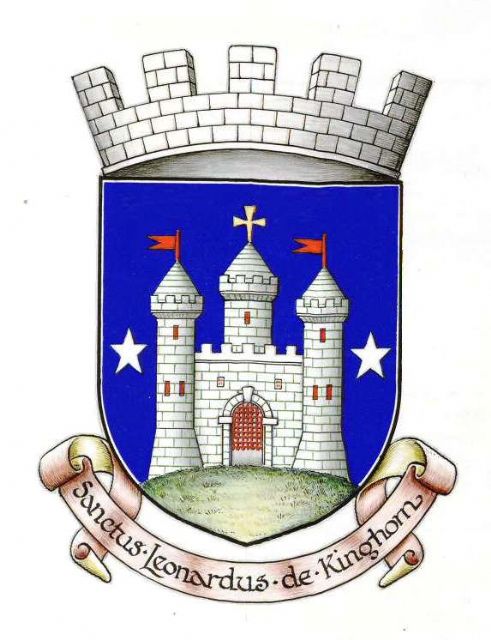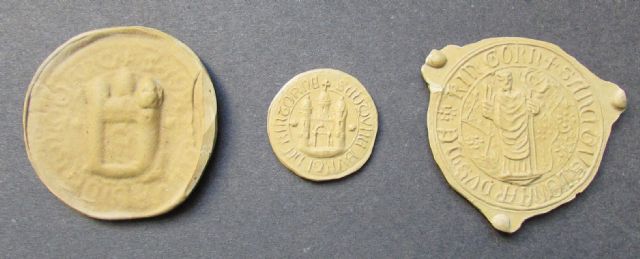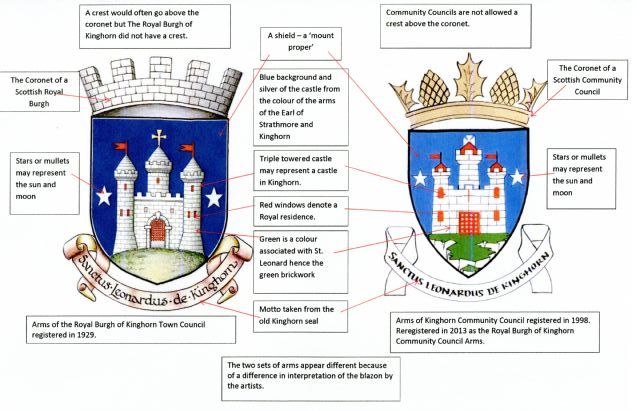The Royal Burgh of Kinghorn Arms

The Arms of the Royal Burgh of Kinghorn registered on 3rd July 1929. Image Courtesy of the Court of the Lord Lyon. Copyright.
We have all seen coats of arms on old buildings, in stained glass windows, above old gateways, on letter headings and at the entrance to towns and villages, but few of us really understand what they are for, or what the symbols mean.
Coats of arms are an ancient form of identification. They were introduced in the 12th century when knights wore armour with helmets that completely covered their faces. There had to be some means of telling friend from foe on a battlefield so the knights put distinctive patterns on their shields and surcoats. Each knight had a different pattern which conformed to a strict system of designs and colours. These came to be known as coats of arms. As more people adopted this form of identification regulation became essential to make sure no two people had the same design. Different countries developed their own system of registration and regulation of arms. In Scotland the Office of the Lord Lyon King of Arms has been officially responsible for overseeing the issue and use of arms since the 16th century. Arms are issued to an individual or an organisation and it is illegal for them to be used by others – just like a passport or a driver’s license. Scottish heraldry is governed by civil law.
In the 1670’s the original register of arms in Scotland was lost – possibly by fire or by the actions of Oliver Cromwell. In 1672 an act of parliament introduced a new Public Register of all Arms and Bearings. All those using ‘arms or signs armorial’ were required to prove their entitlement and register them in the new register. Arms were recorded with a description in words called a ‘blazon’. Artists may interpret (emblazon) the blazon in any style and copyright remains with the artist.
Seals were also used as an ancient form of identification. In medieval times a wax imprint from a seal would be attached to a legal document instead of a signature because many people could not write. Burghs adopted this form of identification. Latterly the seal became a device that embossed the paper that documents were written on. Over time the civic seals were looked upon as ‘armorial bearings’ and burghs were expected to register seals with the Office of the Lord Lyon, although few did. There is little evidence for burghs having arms registered prior to 1672 and few burghs registered armorial bearings between 1672 and the mid-19th century.
On 2nd April 1929 Thomas Innes of Learney, later Lord Lyon King of Arms, wrote a letter to the Scotsman Newspaper highlighting the fact that seventy six Scottish burghs were using unregistered armorial bearings (coats of arms or seals) illegally and pointed out that legal action had been taken in the past against such transgressors. Kinghorn was one of the Royal Burghs illegally using an armorial bearing. The Town Council minutes for 8th April 1929 records a reference to the letter in the Scotsman and the need to register the Burgh’s arms. The Town Clerk was to organise it.
Like the arms of many of Scotland’s old burghs the design was based on the old burgh seal. A blazon for Kinghorn had been published in several books between the 1500s and 1929 using an adaptation of the burgh seal, but it had never been adopted or used by Kinghorn Town Council and it had never been registered. Although the original seal is long lost, a 16th century impression of it is on record. On one side of the seal was a building with three towers and a cross above the centre tower, and on the reverse was an image of St. Leonard giving a blessing with the Latin motto: Sanctus Leonardus de Kinghorn.

Casts taken from seals of Kinghorn Burgh and held in the Office of the Lord Lyon in Edinburgh. L – R: cast from an original 16th century wax seal; cast from the obverse of a seal held in the Town Clerks Office in 1891; cast from the reverse of a seal held in the Town Clerks Office in 1891.
Correspondence from the Office of the Lord Lyon to Kinghorn Town Council in 1929 states:
‘The design on the arms being a very old one, preserved to us in uncoloured seals, there has been some speculation regarding the proper colours, but it would be natural to make these the same as the Earl of Strathmore and Kinghorn’s:- Silver and blue’.
This confirms there were no arms being used up to 1929, only uncoloured seals. The design was taken from the seal and redesigned in 1929 using colours from the arms of the Earl of Strathmore and Kinghorn.
The blazon for the new Kinghorn Burgh Arms was recorded as: ‘Azure, on a mount proper, a castle triple-towered Argent, masoned Vert, windows, portcullis and fans Gules, the middle tower ensigned with a cross pate fitchee Or, between two mullets in fess of the second. Motto: Sanctus Leonardus de Kinghorn.’

Images Courtesy of the Court of the Lord Lyon. Copyright
The shield is the ‘mount proper’ and is coloured azure (blue). The castle is represented as a triple towered castle and is coloured argent (silver) and was assumed to be the Castle in Kinghorn, although a cross on the top would often indicate a church. In 1979 Alexander Cain, who researched the history of Kinghorn Parish Church, suggested the image of the building on the seal represented the west door of the early Kinghorn Church because the cross is so prominent on the 1891 seal. However, the cross on the earlier seal is smaller and not directly connected to the tower. Green is a colour especially associated with St Leonard, so the green brickwork (masoned vert) represents Kinghorn’s patron saint. The red (Gules) windows etc. in the silver castle indicate it was a royal castle – possibly a link with Alexander III. Stars in heraldry represent spurs on personal arms but on civic arms they are taken to represent celestial bodies. The stars, or mullets as they are called, on opposite sides of the shield are thought to represent the sun and moon as opposites: day and night. The coronet above the shield is one that is used in the arms of every Royal Burgh in Scotland and the motto has been taken directly from the seal. Kinghorn Burgh Arms have no crest above the coronet.
The arms were officially registered on 3rd July 1929. The Kinghorn Town Council minutes for 9th September 1929 record: ‘The Clerk exhibited the receipt by the Lyon King (sic) for the matriculation of the Burgh’s Arms. It was decided the receipt should be framed and hung up in the Town Hall …’ The ‘receipt’ in question was in fact a beautifully illuminated image taken from the Public Register of all Arms and Bearings.
At the time of Regionalisation in 1975 the Royal Burgh of Kinghorn ceased to exist and the arms of the Royal Burgh could no longer be used. The Community Council registered new arms in 1998. The design was identical to the old Burgh Arms apart from the Royal Burgh coronet which was replaced with the Scottish Community Council coronet. The two sets of arms illustrated look slightly different because of a different interpretation of the blazon by the artists. At the time of the restoration of the Royal Burgh name to Kinghorn in 2013 a note was placed in the register to reflect the change of name, but the design of the arms remained the same.
So, why did it take so long for the Community Council arms to be displayed on the entry signs to Kinghorn like they were in during the time of the Town Council? Prior to 1975 the Royal Burgh of Kinghorn Town Council used to erect the signs at the entry points to Kinghorn. They owned the signs and they owned the arms, so they could display their own arms on their own signs. After regionalisation in 1975 Fife Council erected the signs at the entry to Kinghorn, but Fife Council did not own the Burgh Arms. It is illegal for Fife Council to display someone else’s arms on their signs. Fortunately the present Kinghorn Community Council has been in discussion with Fife Council and the Office of the Lord Lyon to find a compromise and happily the Community Council Arms are now displayed on the entry signs to Kinghorn.
Ginny Reid
Sources
- Kinghorn Town Council Minutes (1929) pp. 350; 375; 417 (Fife Archives)
- Urquhart, R.M., (1973) Scottish Burgh and County Heraldry. Heraldry Today, London.
- Cain, A., (1979) Kinghorn Parish Church. Allen Litho, Kirkcaldy, printers.
- John Marquess of Bute, McPhial J. R. N., Lonsdale H. W. (1897) The Arms of the Royal and Parliamentary Burghs of Scotland. Blackwood and sons, Edinburgh. p365.
- Images courtesy of the Office of the Lord Lyon, King of Arms (copyright).
